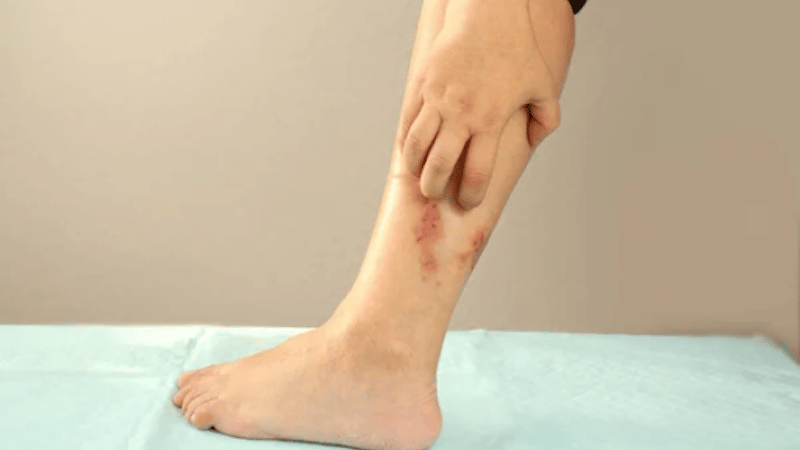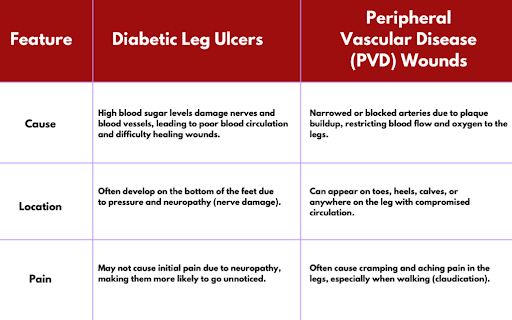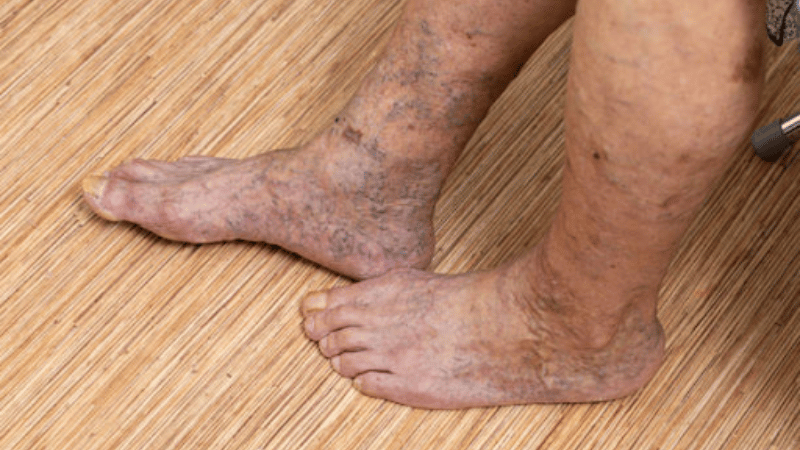Image Above: A recent patient reported that she had dismissed a nagging calf pain and a persistent, non-healing leg as minor annoyances. However, a friend’s concern prompted a doctor’s visit to USA Vascular Centers, where the slow-healing wound raised the possibility of peripheral artery disease (PAD).
The number one reason for wounds to heal slowly is your blood. Certain areas, like your legs or feet, do not have as good of circulation because they are located farther from your heart. If you aren’t getting good blood flow to your lower extremities, you may notice it taking longer for any cut or injury to heal.
Generally, a wound is considered slow-healing if it hasn’t shown significant improvement after four weeks or hasn’t completely healed after eight weeks.
The older we are, slow-healing leg wounds become more common.
This article provides a comprehensive overview of slow-healing leg wounds, including their causes, symptoms, and treatment options.
How to Determine If It’s a Slow-Healing Wound
It’s difficult to determine if your wound is j a minor cut, sore, diabetes ulcer, or peripheral vascular disease wound, but the best way to tell is to monitor its healing progress. Take pictures of your wound and make note of any changes. If your wound gets larger or deeper, call your healthcare provider and report your symptoms and level of discomfort. You’ll also want to:
- Cover any leg wounds that do not heal, but let it breathe for a few hours each day
- Wear loose-fitting clothing and comfortable shoes to avoid irritation to the wounds
- Administer antibacterial ointment at least once a day
- Keep your slow-healing sores clean at all times
- Track its progress and report all changes to your physician
- Consult a vascular specialist if you think an arterial disease like PAD could be the cause
If you notice any wounds on your legs, ankles, or feet that won’t heal, it’s important to consult with a vascular specialist. Our interventional radiologists will examine the wound, perform necessary tests, and develop a tailored treatment plan.
TAKE THE FIRST STEP TO HEALING
Causes of Slow Healing Wounds on Legs
Slow-healing sores or wounds on the legs, ankles, or feet are a common symptom of underlying health conditions. Some common causes include:
- Diabetes
- Autoimmune infection or other immune system issues
- Poor nutrition
- Infection
- Repetitive trauma
- Vein disease and poor circulation
- Peripheral Artery Disease (PAD)
Diabetic Leg Ulcers Vs. PAD Wounds
Diabetic leg ulcers are typically caused by nerve damage or poor circulation, which can cause a numbing sensation in the feet. They typically occur on the feet, near the toes, and soles.
Diabetic leg ulcers and peripheral vascular disease wounds are different, but they share similar causes and risk factors.
Diabetics are at a higher risk of developing PADS, with a Science Direct’s study stating people with diabetes are two to four times more likely to develop peripheral arterial disease (PAD) than those without diabetes.²
Diabetes and PAD often occur together because high blood sugar damages blood vessels, making them less flexible and more likely to develop plaque buildup. Not only does diabetes irritate and inflame the lining of your blood vessels, but it can also compromise your ability to fight infections, which could cause slow-healing wounds on your legs.
Diagnosing the cause of slow-healing leg wounds is important to implement the proper treatment plan and management techniques. If you’re at an increased risk, you should monitor slow-healing wounds or leg ulcers and notify your vascular doctor if any of them worsen.
How Peripheral Artery Disease Can Cause Slow Healing Wounds
Peripheral artery disease is a serious vascular condition caused by plaque buildup in the arteries. This plaque narrows the arteries, making it more challenging for blood, oxygen, and nutrients to reach the lower extremities.
PAD often causes non or slow-healing wounds on the legs, ankles, or feet because vital oxygen and nutrients are unable to reach the lower extremities. If the plaque buildup is too severe, the blockage causes poor circulation, which is crucial for wound healing.
Common Peripheral Artery Disease Symptoms
Slow-healing leg wounds are just one of many common PAD symptoms you should be aware of if you’re at risk. Common PAD symptoms include:
- Leg numbness and weakness
- Leg pain
- Leg hair loss
- Shiny skin
- Leg claudication
High blood pressure, increased cholesterol levels, family history of vascular disease, and type 2 diabetes are all linked as risk factors for peripheral vascular disease wounds.
If you’re experiencing non-healing leg wounds and other PAD symptoms, schedule a consultation with a vascular specialist. A vascular specialist will be able to make a proper diagnosis.
PAD Diagnosis and Treatment Options
Diagnosis starts by determining the underlying cause of your slow-healing wound. If you are diagnosed with PAD, tests such as an ankle-brachial index (ABI) or angiogram can assess its severity, helping your physician to suggest the appropriate treatment plan. The three minimally invasive treatment options your vascular doctor may recommend include:
- Angioplasty: A catheter with a balloon is inserted into the affected artery. The balloon inflates, compressing the plaque against the artery wall.
- Stent placement: After an angioplasty, a permanent stent is inserted into the blocked artery to stop future blockages.
- Atherectomy: A blade or laser is used to physically remove plaque from the artery walls.
Heal Faster. Live Better. Schedule Now.
Slow-healing wounds on the legs are a common symptom of a serious underlying health issue. If you have slow-healing wounds that won’t go away, schedule a consultation with a vascular specialist for an accurate diagnosis.
Call us at 888.773.2193 or click here to schedule online today.
Frequently Asked Questions
Do wounds heal slower as you get older?
As you age, your body produces new cells slower than when you were younger, which can delay wound healing. However, unhealed wounds on your legs are not normal and are caused by something other than aging.
How long does a leg wound take to heal?
Depending on how deep the cut is on your leg and whether or not you have any underlying health conditions like diabetes, it should take three to seven days for the wound to scab over and begin the healing process.
What symptoms should I look out for with slow-healing wounds on the legs?
Symptoms to watch for include persistent pain, swelling, redness, warmth around the wound, foul odor, or drainage. Seeking a healthcare provider is advised if you notice any of these signs.
Can slow-healing wounds on the legs lead to health complications?
Yes, if left untreated, slow-healing leg wounds can lead to serious complications such as infections, tissue necrosis, or even amputation in severe cases. Early treatment is crucial to prevent these outcomes.
Sources
- Chandan K. Sen, “Human Wound and Its Burden: Updated 2020 Compendium of Estimates,” Advances in Wound Care, https://www.liebertpub.com/doi/10.1089/wound.2021.0026
- M. Á. Tresierra & A. García Rojas, “Association between peripheral arterial disease and diabetic foot ulcers in patients with diabetes mellitus type 2,” Medicina Universitaria, https://www.sciencedirect.com/science/article/pii/S1665579617300649?via%3Dihub





